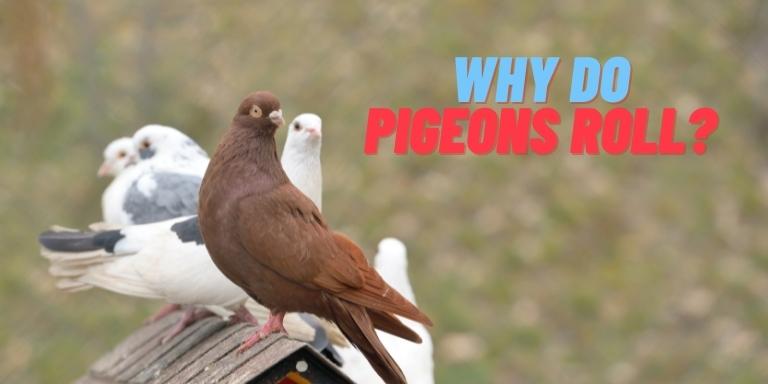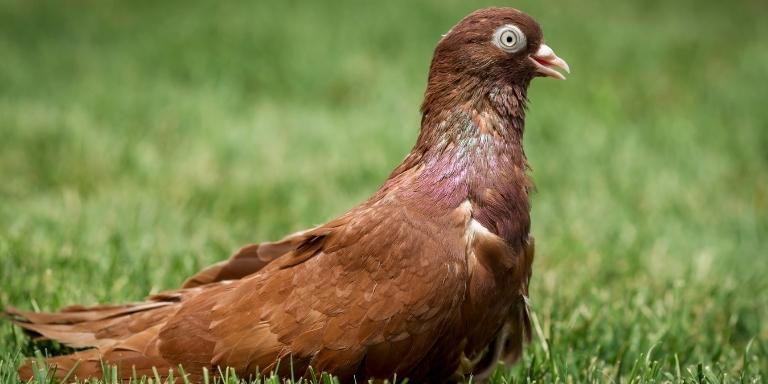The exact cause of pigeon rolling is still unknown. While on a flight, pigeons tumble or somersault backward, but the cause of neurology for this activity is still largely unidentified.
The breed of pigeons that somersault is popularly known as Birmingham Roller. These specific types of pigeons originate in Birmingham, England, and are customized through careful breeding.
The careful selection is based on their ability to fly backward or somersault in the middle of the flight.

Types of Roller Pigeons
There are four types of roller pigeons:
- Birmingham Roller
- Parlor Roller
- Oriental Roller
- Galatz Roller
The Birmingham rollers have two types – Show and Flying-type

The ones for the show are called ‘Show Rollers‘ and are larger in size than the flying ones. They are bred just for show.
Another similar breed known as Parlor Roller is also bred for the show. They look like Birmingham rollers, but they don’t fly. They spin backward and somersault on the grounds. They can do this for many yards.
Oriental rollers are another type of pigeon that are bred just for show. They are aerial and come in several colors.
Galatz roller originated from Romania and is very popular among pigeon fanciers from Romania as well as Europe.
Why Do Roller Pigeons Roll?
It is still an unknown fact why the rolling pigeons roll. Even though breeders give varieties of explanations, it hasn’t yet been scientifically proven why they do it.
However, these birds have a genetic inclination toward rolling and tumbling in flight, although this activity will be based on adequate diet, exercise, and training.
The pigeon fanciers say that they dive in the air so fast that they look like a feather or a cricket ball falling off the sky.
A fancier named William Pensom describes the motion as raising the wing, clapping, and putting the tail slightly downwards. He states that the Birmingham roller, although not very deep, can act like a cricket ball spinning down towards the earth.
In recent times, more extensive studies have concerned their mode of inheritance of rolling and tumbling. It has been suggested that these are the same phenomena, except for the difference between the height and the flight duration.
On the ground, the parlor rollers rolls and somersault on the ground in a motion that is the exact opposite of what the pigeons would do if they were preparing to fly.
Is Pigeon Rolling Cruel?
Roller pigeons are selectively bred, fed, raised, and trained for aerial shows. However, these acts often pose a deadly threat to the birds as they lose control in the dive or are hit by raptors.
Thousands of breeders from around the world breed the Roller pigeon who flips backward when flying. They sometimes get injured in the process and can have seizures as well.
Excessive training of the birds for this particular act that can be life-threatening is considered cruel by many. The fanciers might find it fancy, but the sport that endangers the birds cannot be regarded as enjoyable.
Differences Between Rollers and Tumblers
The main difference between rollers and tumblers is that tumblers spin only once in the air, whereas rollers dive and perform somersaults multiple times during the same flight.
Four types of pigeons are in question – flying and parlor tumbler, flying and parlor rollers.
All of these species will generally fly for a few weeks and then automatically start to perform somersault or backward diving.
However, the parlor rollers will ultimately stop flying and only perform dives and somersaults on the ground whenever they attempt to flee.
Due to their ability to perform, tumblers will descend to only a smaller altitude, whereas the roller will fall a great length while performing their acts.
The excellent types of rolling pigeons are Birmingham rollers, Parlor rollers, Oriental rollers, and Galatz rollers.
It is suggested that the best time to fly rollers is an hour before sunset. They can fly up 30 to 60 minutes at a stretch. However, pigeons can usually fly up to 700 miles a day.
All pigeons have homing instincts. Scientists have discovered that they do this by leaving a trail of odor by which they orient themselves back to where they belong or consider their home.
The rollers should be raised in the safety of your home first until they fly higher and longer. Once they recognize their home, they can go and join the kit.
Conclusion
Pigeon rolling show is considered an enjoyable hobby for many pigeon fanciers, but it can actually endanger the bird’s life.
You might also be interested in: